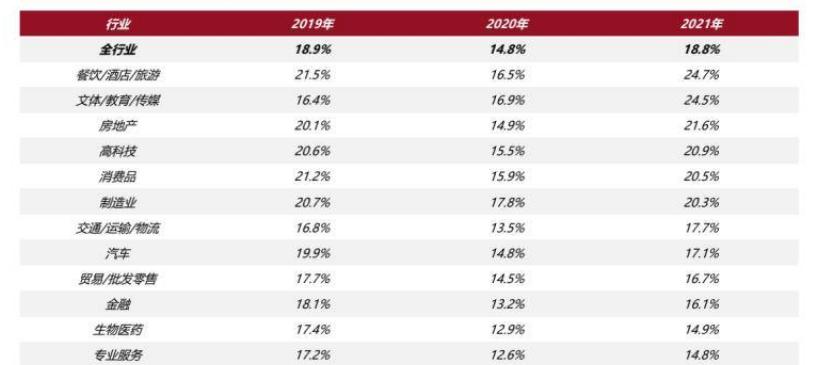Reporter | Chen Xiaozhen
Edit |
1
Recently, the "2022 Departure and Salary Adjustment Survey Report" (hereinafter referred to as the "Report") released by 51job shows that the overall employee turnover rate in 2021 is 18.8%, up 4.0 percentage points compared with 2020, and the active departure rate is 14.1%, up 6.0 percentage points from 2020.
The report pointed out that as the new crown epidemic eases nationwide and the economy continues to recover, both enterprises and employees have jointly promoted the recovery of the turnover rate in 2021.
From the perspective of industry, the active turnover rate of the catering/hotel/tourism and high-tech industries ranked among the top, with 16.9% and 15.9% respectively. As a labor-intensive industry, catering/hotel/tourism has a low level of stability due to the younger age of grass-roots employees. At the same time, sporadic outbreaks of the epidemic still have an impact on business operations, and the performance income of related employees has declined significantly. The demand for talents in the high-tech industry is strong, especially the demand for high-end talents such as chips continues to grow, and the flow of talents in the industry is active.

Source: 2022 Separation and Salary Adjustment Survey Report
Employee turnover rates in the cultural, sports/education/media, and real estate industries are also relatively high, with 24.5% and 21.6% respectively, ranking second and third. Among them, the high turnover rate of the cultural and sports/education/media industry is mainly due to the large-scale layoffs of education and training institutions under the double reduction policy, and the passive turnover rate is high to promote the overall turnover rate at a high level. Some housing enterprises have adjusted their organizational structure or optimized layoffs, which has also promoted the overall turnover rate.
From the perspective of cities, the turnover rate of first-tier cities and non-first-tier cities in 2021 has rebounded compared with 2020, of which first-tier cities have rebounded by 4.7 percentage points, non-first-tier cities have rebounded by 3.5 percentage points, and the turnover rate of first-tier cities is still higher than that of non-first-tier cities. The report predicts that with the gradual rise of new first-tier cities and the industrial transformation and upgrading of lower-tier cities in the future, the gap between the turnover rate between first-tier and non-first-tier cities will be further narrowed.
It is worth mentioning that in 2021, enterprises that choose to raise salaries have become the mainstream, reaching 88.4%, a substantial increase over 2020. At the same time, the salary adjustment coverage rate of enterprises has also rebounded, and in 2021, the salary adjustment coverage rate of supervisors, professional and technical personnel, general employees and general operators has risen to more than 50%.
From the perspective of various industries, the salary increase range of each industry in 2021 will rebound compared with 2020. Among them, the high-tech, biomedical and financial industries rank in the top three in terms of salary increases. This is mainly related to the fact that these industries are less affected by the epidemic, the demand for professional and technical personnel is strong, and the ability to pay wages is strong.
Among the enterprises that choose to raise salaries, 15.9% of enterprises choose full general adjustment, 72.5% of enterprises choose partial salary adjustment, and only 11.6% of enterprises with frozen salaries are only 11.6%.
In addition, "differentiation" has become the main tone of salary increase in 2021. The impact of the epidemic has made cost control and efficiency improvement a consensus of more enterprises: in the case of limited budgets, enterprises consciously tilt resources to high-performing employees, core departments, and core employees. 43.5% of the companies that "differentiated salary adjustment according to the results of performance evaluation" and 28.9% of the enterprises that "adjusted salaries according to the same proportion or amount" were only 9.3%.
In terms of hierarchy, top management is more motivated through medium- and long-term incentive programs, so the salary increase coverage rate is relatively low. Taking into account factors such as the rising cost of living, front-line operators have the highest salary adjustment coverage rate, reaching 66.2%. It is expected that the salary adjustment coverage ratio at all levels will be slightly narrowed in 2022, but the overall salary adjustment coverage ratio will remain above 40%.
The report pointed out that the global epidemic is still evolving, the external environment is complex and changeable, and the domestic economic recovery is still unstable and uneven; it is expected that the salary increase range of enterprises will decline slightly in 2022, with a salary increase rate of 6.0%.